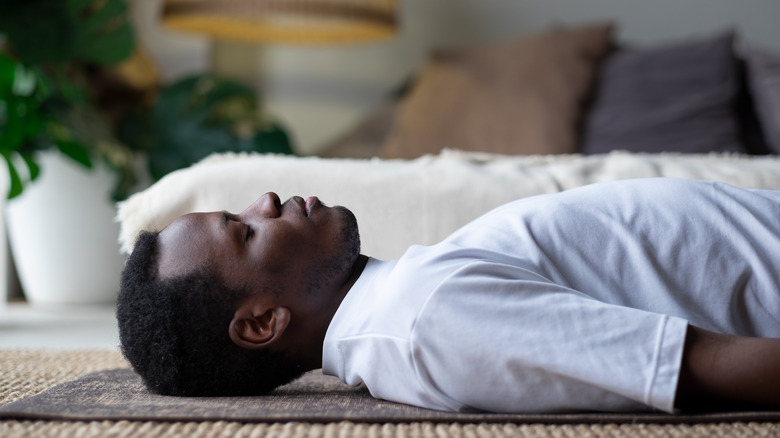Stress is more than just an unpleasant feeling, it’s an actual stone-cold killer. Besides making you tense and putting you in a bad mood, stress can put you at risk for deadly conditions including heart attacks, according to the American Heart Association. Stress is also oftentimes the culprit when it comes to ulcers and other digestive issues, back and neck pain, obesity, and sleep disorders, and can even lower your resistance to infections like the common cold, according to the American Association of Retired People (AARP).
But there is a silver lining here. The truth is that stress is a reaction to adverse events that are mediated by your own mind. According to Harvard Health Publishing, the stress response begins in the brain before it triggers the hormonal reactions that cause physiological effects. With this being the case, then is it safe to say the mind can be trained to stop the stress response and de-escalate those raging hormones? You bet, and here are five easy and quick practices you can do to prove it to yourself.
Count down from 5

When a situation happens that triggers in you a stress reaction, sometimes merely taking your mind off the event can effectively deactivate the response. One of the easiest ways to shift your attention away from a disturbance is by counting. If you find that your thoughts keep going over and over a stressful situation, you can put your attention on counting slowly until you calm down, and save yourself a lot of tension and anxiety.
The Mayo Clinic has a version of this exercise that forces you to focus on your surroundings as you countdown to zero. Starting at five, you pay attention to all the things you see around you. At four, move your attention to what you can feel, like the fit of your shoes or the surface of what you’re sitting on. When you get to three, notice all the sounds around you. Is that a car passing by? A dog barking in the distance? For two, use your sense of smell. What’s that floral fragrance you’re picking up? At one, ask yourself what you can taste. If you find your stress level rising at any step in this exercise, repeat that step until it gets your full concentration before moving on.
Practice body scanning

One of the best ways to get out of your head is to get into your body. Dancing, yoga, doing sports, and working out at the gym are as effective in releasing stress as they are in providing physical benefits (via Harvard Health). When you feel stressed out but don’t have the time or opportunity to go for a run or to a fitness class, simply turning your attention to the sensations in your body can be a powerful way to relax.
Body scanning is a mindfulness meditation technique that medical experts say is a powerful tool for stress reduction. The UC Berkeley Center for the Greater Good, for example, recommends a simple body scan meditation that can be done sitting or lying down in as little as five minutes. You begin by bringing your attention to the bottoms of your feet, then slowly moving your attention up your legs, up through your midsection and torso, along your arms, across your chest, up your neck and face all the way up to the top of your head. Scan your body very slowly, relaxing each area one by one, and repeat.
Control your breathing

fizkes/Shutterstock
It’s no secret that our emotional state is expressed in the way we breathe, but did you know that to a certain extent the reverse is also true? Yes, you can affect your emotional state by controlling your breathing. According to Harvard Health, simply by changing our breathing rhythms from short and shallow (which we usually default to in times of stress) to long, slow, deep breaths, we can automatically switch on what the researchers call our innate “relaxation response.”
It’s easy to manage your breathing in order to achieve this effect, and it can be done standing, sitting, or lying down. First, just take a normal breath. Then, on your next inhale, slowly inhale through your nose, letting your lower belly expand and chest rise, and keep breathing in until your lungs feel full. Pause here for a second, and then with a controlled and slow exhale breathe out through your mouth (per Harvard Health). Practice this controlled breathing for at least five minutes and you will feel the stress float away like a soft breeze.
Focus on gratitude

fizkes/Shutterstock
Most often, stress is tied to unwanted situations in our life: the loss of a job, a financial setback, the end of a relationship. While mourning the loss of anything or anyone is normal, the excess stress associated with the feeling of worry can be damaging to our health. This is where gratitude comes in. According to a recent article in the Harvard Business Journal, just shifting our focus to things we are grateful for can be a powerful mental exercise that beats the stress response.
A helpful practice is keeping a gratitude journal, in which you can regularly jot down things big and small — your pet, your friendly neighbor, the sound of rain pattering on your window — that you appreciate. When you’re in the midst of a stressful situation, you may feel too overwhelmed to write in your journal. But by turning to your journal and reading what you’ve written before, you’ll be reminded of all the blessings in your life, which can help lower your stress levels.
Start a meditation practice

fizkes/Shutterstock
Meditation has emerged as one of the top ways to beat stress, available to everyone, regardless of their background, religious beliefs, or physical condition. According to a 2024 study published in the Journal of Alternative and Complementary Medicine, even young adults who had never practiced meditation before experienced significant drops in markers of both physiological and psychological stress after just one 20 minute meditation session.
If you’ve never tried meditation, you can find a teacher in your area or check out one of the countless meditation apps out there to help guide you. There are many different techniques, but the end goal of meditating is the same. According to the Mayo Clinic, meditation induces a state of mind where you are not overwhelmed by jumbled or stressful thoughts but instead reach tranquility and a deep feeling of relaxation. The key to meditation is developing the ability to let go of your thoughts and not get attached and entangled in them, like watching the clouds float across the sky without chasing them. Begin today and reap the benefits for life.




